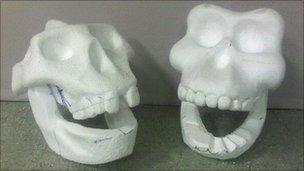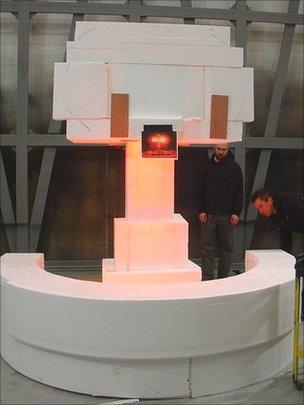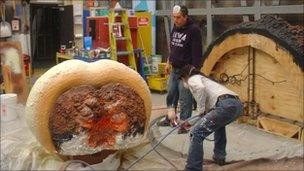Tech Know: Carving an atomic bomb
- Published
Jesse Smigel's collection includes a robotic beetle, a machine that plays decades-old phone calls and a model of an atomic blast, as Andrew Webb discovered
If you think of Las Vegas then, depending on what you got up to there, art is perhaps the last thing that comes to mind.
But art, artists, hackers and makers can be found scattered lightly amid the neon, gambling halls and showgirls.
For Jesse Smigel, a working artist based in Vegas, there is no contradiction here.
Art is, after all, about using the right media and materials to fulfil an artist's vision and evoke a reaction. In other words, art is what you can get away with - and Vegas knows all about that.
"I'm pretty sure that they did not get stonemasons to carve the columns on the front of Caesars Palace," said Mr Smigel. "Half of Vegas is made of foam."
When it comes to foam, or expanded polystyrene, Mr Smigel knows what he is talking about. This is because his day job and the art he produces involves turning blocks and sheets of it into works that look nothing like the familiar white material.
In his day job Mr Smigel creates scenery and props for the Judy Bayley theatre at the University of Nevada, Las Vegas. It's a hectic schedule that sees him build the scenery and props in a month for a show that runs for three weeks.
At the end of the run the props, big and small, are sold off or broken up.
Foam gnome
In his creative life, he has used foam as a medium to create a series of strange, and sometimes unsettling works.
He has made a titan cicada; an infant that is half-child and half grub; and a giant garden gnome - and is planning a gigantopithecus that tells jokes in the style of ribald comic Andrew Dice Clay.

Jesse Smigel often starts his work with a chainsaw before moving to more precise tools.
Saddle those to other completed creations such as a booby-trapped box of popcorn and purring cactus and it is easy to see why his work has been called "eccentric".
His current project is something different. He has been commissioned to depict a nuclear explosion - a mushroom cloud - in expanded polystyrene. In a week.
The sculpture's commissioner is the Atomic Testing Museum which plans to make it the first thing that people see when they visit the newly opened Building Atomic Vegas exhibition.
The museum has brought together testimony from Vegas residents who lived in the city when nuclear tests were being carried out just over the nearby mountains.
Bomb parties
Between 1945 and 1962, about 100 above-ground tests were carried out. The light pulse, shock wave and mushroom cloud could all be seen from Las Vegas. Many times, residents threw cocktail parties and gathered outside while a test was being carried out.
The early growth of Las Vegas was due almost entirely to the boost in prosperity it got from the huge numbers of scientists, test ground staff and soldiers that worked on the atomic tests.
Initial work on the sculpture involved creating a huge "T" from foam that would form the central mushroom cloud.
Next came a low bank of foam around the base, carved into a rolling mass of clouds and designed to serve the dual purpose of preventing museum goers from poking the sculpture.

The atomic blast began life as a collection of polystyrene blocks.
Mr Smigel rated the task of turning this unprepossessing bunch of blocks into a mushroom cloud as a six on the scale of difficulty.
"It's just time that kicks it up one," he said. "It has to be done pretty fast."
In his early days as a foam carver he made maquettes and drawings to refine what the finished work would look like.
Not any more.
"Now, I have the confidence to just do it," he said. "Plus, I've been thinking about it a lot, turning it over in my head."
The good thing about depicting a mushroom cloud is that there are no current real-world examples to compare it against, he said.
By contrast, he said, get the proportions of a tree or dinosaur wrong and people will instantly spot the fault.
But that lack of real-world guides also gives rise to some nervousness.
"The problem is that it's massless," said Mr Smigel. "With an animal or a tree you know what goes where, that's not so with this."
Hellish forces
Despite the nerves, the first tool Mr Smigel turns to when starting carving is an electric chainsaw. That is used to carve out the rough shape.
A reciprocating saw helps refine the rough outline and then rasps, curry combs and even a beef knife are used to add detail.

Coatings are applied to the foam to make it more durable before being painted.
Carving the foam is just the start of the project.
After that comes a series of coatings that turn the flimsy foam into something more durable, then paint to accentuate details and lights to make the whole cloud glow like it is lit by the hellish forces of an atomic blast.
The work takes a week to complete. When assembled in the exhibition hall at the museum the sculpture looks just like it should - a miniature atomic explosion.
As every artist before him, Mr Smigel is not as happy with his creation as those who only see the before and after. He has lived with it and knows its flaws.
Despite this, there is satisfaction to be had in the work he has done and how fast.
"The timings made it tight," he said, "but we did pretty much make magic happen here."